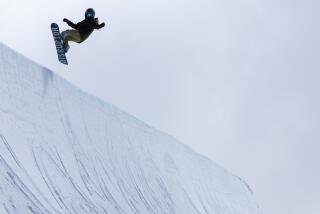Ski Industry Wages an Uphill Battle for Brighter Horizons
DENVER — Adam Aron figures he doesn’t need a human-sized mouse with big ears to lure vacationers to his playground.
What he does need, though, is a way to convince harried Americans that there is more respite on his mountaintops of waist-deep snow and towering pines than at a theme park.
“What we’re competing against is a beach in Hawaii or a ship in the Caribbean or some other use of the discretionary dollar,” said Aron, who heads Vail Resorts Inc. “As a result of that, we have to offer at our resorts the kinds of alternatives and options that consumers are getting in other places.”
A former cruise line executive, Aron has set Vail Resorts on a course to meet that challenge by acquiring four resorts and raising $266 million in an initial stock offering.
It was one of four major mergers in the ski industry over the last year, part of an ongoing consolidation designed to bolster growth by making resorts less dependent on weather and more attractive to a new generation of sports enthusiasts.
“Consolidation is just a fact of business life today,” said Michael Berry, president of the National Ski Areas Assn. “The ski industry is no different than any other business in this country today, whether it’s the grocery store or the auto dealership.”
For decades, the 63-year-old ski industry enjoyed healthy growth thanks to the baby boomers, who embraced the sport. All a resort had to do was provide skis, a lift to the top of a mountain and nourishment.
In the late 1970s, artificial snow-making entered the scene, revolutionizing the industry.
“It became obvious that snow-making was fundamental. . . . It also required resorts to make a significant capital investment. That really caused the demise of the mom-and-pop ski area,” Berry said.
As resorts began pouring capital into the technology, skiers began to change. Aging baby boomers, estimated at 78 million, were replaced by Generation Xers, who number about 44 million, Berry said.
“When, in fact, the Generation Xers were in their late teens and early 20s, the industry struggled with that. They didn’t know why [skier numbers diminished],” Berry said. “We were talking to fewer people.”
To survive, the resorts began to consolidate and diversify.
“The historical model for ski companies was based on just selling the lift ticket and a burger,” Berry said.
Today, the companies are selling everything from T-shirts to real estate, which has helped boost industry revenues from $1 billion to $1.5 billion a decade ago to $2.5 billion this year, he said.
At the same time, the number of resorts dwindled from 709 in the 1985-86 season to 519 in 1995-96, the ski areas association says. About a dozen companies own the top 50 or 60 resorts in the United States.
Skier visits--the industry measure that represents one person visiting a ski area for any part of a day--averaged 50 million in the ‘80s, but increased to 54 million last year, the ski areas association says.
Bob Wilbanks, who publishes the National Ski Club Newsletter, said skiers have been more concerned about whether lift ticket prices will increase than who owns the resorts.
“The industry is perhaps maturing, but so is the consumer,” he said. “You’ve got better food. You can ski more in probably six hours, or four hours, even than you skied in 1978.
“It’s becoming a little more sophisticated, an all-encompassing vacation.”
Nestled near the Continental Divide of the Rockies, Vail is a good example of the industry’s transformation.
Founded in 1962 by a group of investors, it offered $5 lift tickets for a day of skiing on groomed trails through pristine forests.
In 1985, George Gillett purchased the company and turned it into the nation’s top resort with high-speed chairlifts and an expanded ski school.
Gillett’s luck turned bad in the early 1990s, and the company was purchased by financier Leon Black, who continued to pour money into improvements.
Today, Vail charges $52 for a lift ticket for a day of skiing across 4,100 acres of terrain, accessible by a network of high-speed chairlifts. The company also owns nearby Beaver Creek, which offers 1,530 acres of ski terrain.
In addition to the sleek slopes and mogul-filled steep drop-offs, the mountains offer everything from an ice rink to upscale restaurants and a business center.
Like many other mountain resorts, Vail has added summer activities, including golf courses, hot-air ballooning and mountain biking.
About the time Aron became its chief executive officer last summer, the company agreed to purchase Breckenridge, Keystone and Arapahoe Basin from Ralcorp Holdings for $310 million, creating the world’s largest ski company.
The Justice Department has approved the merger as long as Vail sells Arapahoe Basin to comply with antitrust laws. Without A-Basin, the resorts have about 4.65 million skier visits a year, which is about 10% of the nationwide total.
The company took another giant step in January, raising $266.2 million in a stock offering that made it the only major publicly traded ski-resort company in the United States.
Aron moved into the ski industry after working in marketing with United Airlines and Hyatt Hotels and then as CEO of Norwegian Cruise Line Ltd.
“It used to be that ski resorts were concepted solely around lifts and trails. Now ski resorts are focused around the minute the first phone call is made from a potential vacationer,” he said.
More to Read
Inside the business of entertainment
The Wide Shot brings you news, analysis and insights on everything from streaming wars to production — and what it all means for the future.
You may occasionally receive promotional content from the Los Angeles Times.









